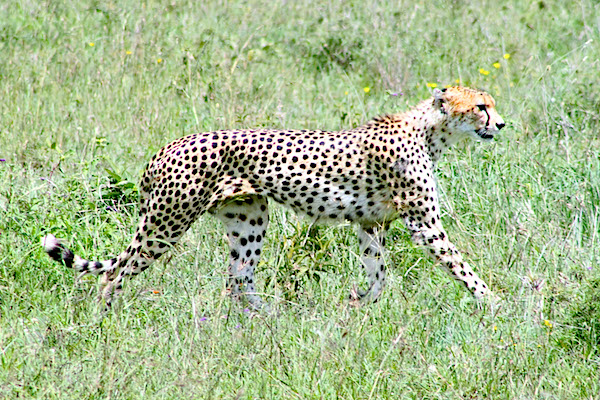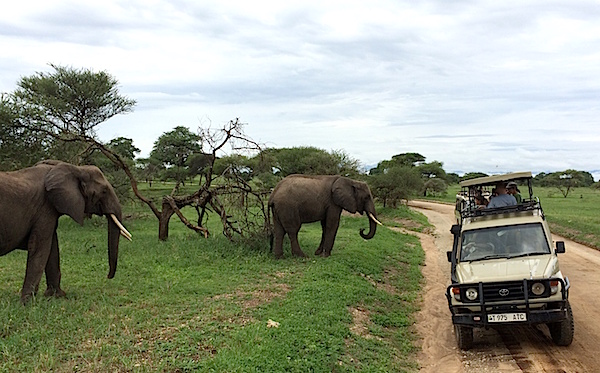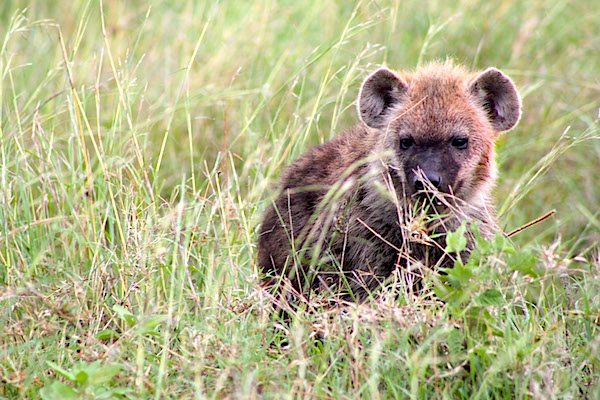 Safaris in national parks in Africa can lead to close encounters with wildlife, such as this cheeta/Sean Smith
Safaris in national parks in Africa can lead to close encounters with wildlife, such as this cheeta/Sean SmithEditor's note: Sean Smith is a former Yellowstone National Park ranger, and an award-winning conservationist, TEDx speaker, and author. He recently had the opportunity to visit some national parks in Tanzania, and returned home with thoughts of what the National Park Service might learn from its African colleagues.
I recently returned to the Northwest after a two-week Tanzanian safari. It was an amazing experience. The trip took us through Arusha, one of Tanzania’s larger cities, out to Tarangire and Serengeti national parks, and the Ngorongoro Conservation Area. The parks and conservation areas were filled with wildlife from the ubiquitous wildebeest to the rare black rhino.
African National Parks share many similarities with their American counterparts.
The parks are big. Serengeti, for example, is more than 3.7 million acres or roughly 1.5 times the size of Yellowstone. Put another way, Serengeti is larger than the state of Connecticut.
The parks are well-visited. Despite having to travel over many poorly maintained dirt roads, parks like the Serengeti and Ngorongoro see roughly 1 million tourists annually.
The parks protect natural and cultural resources. The Tanzanian Park Service, like its U.S. counterpart, protects both natural and cultural resources. Olduvai Gorge in the Ngorongoro Conservation Area protects one of the world’s most important historic sites and some of the oldest fossilized human remains. They like to say at Olduvai, if one traces his/her lineage back far enough, everyone is from Tanzania.
Yet, the Tanzania Park Service diverges from the U.S. National Park Service (NPS) on many issues. The African approach on several issues is an approach the NPS should copy.
Conservation over Recreation
The Tanzania Park Service places conservation and the protection of natural resources and wildlife over private recreation. Nearly every visitor to Tanzania’s national parks has a guide. These guides receive extensive training on resource and wildlife protection. The guides are taught to get the visitors deep into the parks for close-up but safe interactions with the wildlife. Private recreation such as hiking, mountain biking, and swimming is practically non-existent.
Yet, despite this focus on guided rather than private access, park visitors report high satisfaction with their safari adventures.

Elephants seemingly are habituated to humans and their vehicles/Sean Smith
Here in the United States, the NPS mistakenly promotes the idea that it has a dual mandate, one that requires the NPS to balance conservation with recreation. This is incorrect and the courts have consistently ruled that when there is a conflict between conservation and recreation, the law requires the Park Service to favor conservation. The Park Service’s continued pushing of the dual-mandate myth creates undue management headaches, as every recreation interest from snowmobiles to off-lease dog walkers demands access to the national parks. As a result, the national parks are compromised by questionable activities that in many instances do not require a national park setting to enjoy.
Africa takes conservation crimes seriously
Tanzanian park rangers and their African counterparts take environmental crimes seriously. During our safari, I asked our guide if the truck broke down, how would we contact the rangers for help? Our guide responded, “We wouldn’t. The rangers' job was to patrol the borders looking for poachers. We would have to get ourselves up and running again.”
This focus on poaching was recently rewarded when Tanzanian police arrested Feisal Muhammad Ali, the world’s most-wanted ivory trafficker. Meanwhile, rangers in South Africa shot and killed suspected rhino poachers. While I’m not advocating for the summary execution of park criminals, the U.S. government could do more to increase the understanding of the severity of environmental crimes. However, its handling of the Cliven Bundy standoff in Nevada and the courts' unwillingness to impose stiff penalties for poaching sends the message that resource crimes are no big deal.

Hyena in the grass/Sean Smith
Focus on experiences
Another area of focus for the Tanzania park rangers is a on visitor experience rather than amenities. To say the roads of Serengeti and Ngorongoro are rough is an understatement. In some instances, park roads are little more than a mud streak. Meanwhile, the Tanzanian national parks spend little on so-called necessities such as Wi-Fi and cellphone coverage. Interpretive displays are often rudimentary and lack any high-tech whiz bang features found in the United States. However, they provide information in multiple languages, increasing public understanding of why the parks are important.
Rather than providing distractions, the Tanzanian parks focus on preserving authentic experiences. An authentic experience is one that improves a visitor’s appreciation and understanding of park wildlife and natural features, while allowing low-impact intimate interaction with those resources. Unfortunately, many U.S. park activities significantly diminish authentic experiences.
America’s National Park Service will celebrate its 100th birthday in 2016. During the upcoming year, it’s expected the NPS will seek public comment on how best to ensure the park system and Service reach their bicentennial. The agency should look to Africa for guidance.
Sean Smith is a former Yellowstone Ranger, and an award winning conservationist, TEDx speaker, and author. He writes national park thrillers from his home in the shadow of Mount Rainier National Park. To learn more about his conservation work and novels, check out his blog: www.seandavidsmith.blogspot.com or follow him on twitter: @parkthrillers

 Support Essential Coverage of Essential Places
Support Essential Coverage of Essential Places







Comments
Well, since the "rich elites" going to Africa obviously can't already be living in Africa, and the only others mentioned are Americans, then I'm not sure who else W could be referring to.
The entrance fee for Tangarine is $22. I was in Mole NP and, like I said, most people there were (West) African.
Are you asking me if I want America's National Parks to be more expensive?
The opposite of conservation is consumption - the joy of the profit-motive crowd.
Problem is, once something is consumed, it's gone. Take a look at the mountains in the east that used to have mountaintops.
This is a hoot. EC completely fails to see any irony in his comment above at 9:38 p.m.
He's exactly right, though. Even though he apparently can't understand the need for us to work hard to prevent our parks and natural resources from becoming Ethiopianized.
And is it possible that those "snobs" who visit these African parks just might be the beginning of something that might at some time in the future, help lift the African people who live nearby out of poverty?
Sort of the same way that Canyonlands and Arches have helped lift the natives of Moab, Utah out of poverty?
Europeans, Asians, South Americans, Australians .........
Which is more than 2% of what the average Tansanian earns in a year. 2% of the average US income would put the entrance fee over $1,000. How many average Americans would visit a park with that fee?
Once again you want to play word games rather than understand the point that is being made. The point is the average African can't afford to go to these parks. They are visited by the relatively rich. Some of which may be African but a major portion, if not vast majority are foreign visitors, American and otherwise, like yourself that are massively wealthy in comparison to the indigenous population.
No, the joy of the profit motive crowd is creation. People don't get into the top 1% by spending all their money.
Could you identify those mountains and explain how we are worse off for them not having "tops".
You are right Lee, I fail to see the irony. Perhaps you could explain it again. Your last attempt made absolutely no sense. Please start by explaing how I want to Ethiopianize parks.
T'would be completely futile, friend EC. Once again you want to play word games rather than understand the point that is being made.
It's possible most of the above discussion has missed one of the author's key points: "...every recreation interest from snowmobiles to off-lease dog walkers demands access to the national parks. As a result, the national parks are compromised by questionable activities that in many instances do not require a national park setting to enjoy."
He has a point that in trying develop our national parks (and related NPS sites) to cater to every form of recreation possible (whether that be horse use, mountain bikes, motor boats, campgrounds for motor homes, ATV's, snowmobiles, luxury hotels and so on...along with the growing demands for high speed internet and cell service in parks), we run the risk of losing what makes those areas special.
Should all visits to our parks be limited to guided tours on dirt roads? Certainly not, but there is room for discussion about how much is too much when it comes to "amenities" inside parks. I'd suggest the proper balance for our parks lies somewhere between the "African model" and the present-day Yosemite Valley.
This story is just the latest version of the ongoing debate between preservation and recreation in the parks, and there are plenty of fans of both, so this one won't ever be resolved to everyone's satisfaction.